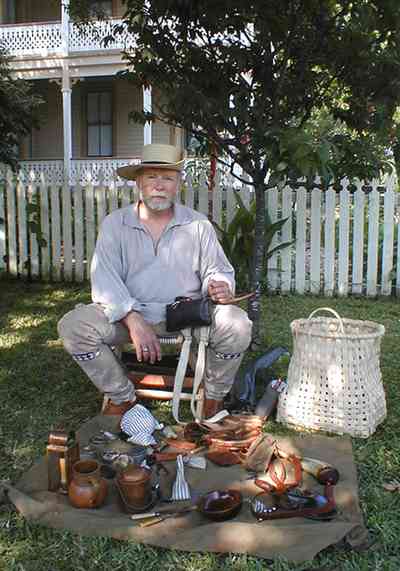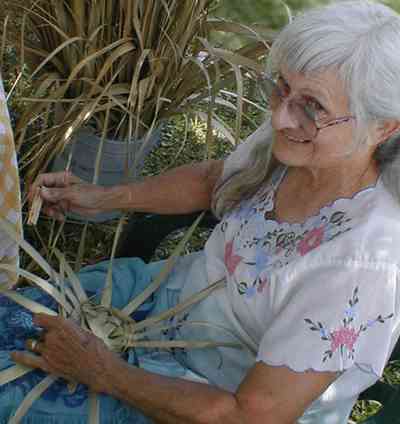-

The historic marker can be seen from the sidewalk on Zaragoza Street. The cottage can be seen on the left. In 1804, Francis Heindenberg received from the Spanish governor a lot in the city of Pensacola. Four years later he sold the property to a free black woman named Julee. The sale included a “low wooden house which I have built at my own expense”. Both house and lot sold for three hundred dollars. The house was probably built between 1804 and 1808.
-

Two boys play chess as living history re-enactors during the summer open house at Historic Pensacola Village.
-

Tom Garret portrays a 1812 US Infantryman and woodworker. He is accompanied by his two sons who are also in period dress.
-

Tom and his sons are participating in the 11th Annual Summer Open House of the Historic Pensacola Village.
-

Eddie Rogers demonstrates the skills and materials used by an 1812 militiaman.
-

Sally Way is a re-enactor demonstrating spinning techniques used during the colonial period.
-

Nancy Wernicke demonstrates colonial quilting styles and techniques at the 11th annual Summer Open House at the Historic Pensacola Village.
-

Chair caning is an exacting craft demonstrated by a re-enactor at the Historic Pensacola Village.
-

Mary Sanford prepares a basket made from palmetto fronds.
-

The area east of the Weavers Cottage was the site for a demonstration by the Spirit of '76 Fife and Drum Corps. Vick Vickery stands in the foreground.
-

Reeder Smith demonstrates drumming techniques.

 The historic marker can be seen from the sidewalk on Zaragoza Street. The cottage can be seen on the left. In 1804, Francis Heindenberg received from the Spanish governor a lot in the city of Pensacola. Four years later he sold the property to a free black woman named Julee. The sale included a “low wooden house which I have built at my own expense”. Both house and lot sold for three hundred dollars. The house was probably built between 1804 and 1808.
The historic marker can be seen from the sidewalk on Zaragoza Street. The cottage can be seen on the left. In 1804, Francis Heindenberg received from the Spanish governor a lot in the city of Pensacola. Four years later he sold the property to a free black woman named Julee. The sale included a “low wooden house which I have built at my own expense”. Both house and lot sold for three hundred dollars. The house was probably built between 1804 and 1808. Two boys play chess as living history re-enactors during the summer open house at Historic Pensacola Village.
Two boys play chess as living history re-enactors during the summer open house at Historic Pensacola Village. Tom Garret portrays a 1812 US Infantryman and woodworker. He is accompanied by his two sons who are also in period dress.
Tom Garret portrays a 1812 US Infantryman and woodworker. He is accompanied by his two sons who are also in period dress. Tom and his sons are participating in the 11th Annual Summer Open House of the Historic Pensacola Village.
Tom and his sons are participating in the 11th Annual Summer Open House of the Historic Pensacola Village. Eddie Rogers demonstrates the skills and materials used by an 1812 militiaman.
Eddie Rogers demonstrates the skills and materials used by an 1812 militiaman. Sally Way is a re-enactor demonstrating spinning techniques used during the colonial period.
Sally Way is a re-enactor demonstrating spinning techniques used during the colonial period. Nancy Wernicke demonstrates colonial quilting styles and techniques at the 11th annual Summer Open House at the Historic Pensacola Village.
Nancy Wernicke demonstrates colonial quilting styles and techniques at the 11th annual Summer Open House at the Historic Pensacola Village. Chair caning is an exacting craft demonstrated by a re-enactor at the Historic Pensacola Village.
Chair caning is an exacting craft demonstrated by a re-enactor at the Historic Pensacola Village. Mary Sanford prepares a basket made from palmetto fronds.
Mary Sanford prepares a basket made from palmetto fronds. The area east of the Weavers Cottage was the site for a demonstration by the Spirit of '76 Fife and Drum Corps. Vick Vickery stands in the foreground.
The area east of the Weavers Cottage was the site for a demonstration by the Spirit of '76 Fife and Drum Corps. Vick Vickery stands in the foreground. Reeder Smith demonstrates drumming techniques.
Reeder Smith demonstrates drumming techniques. One Tank of Gas
One Tank of Gas